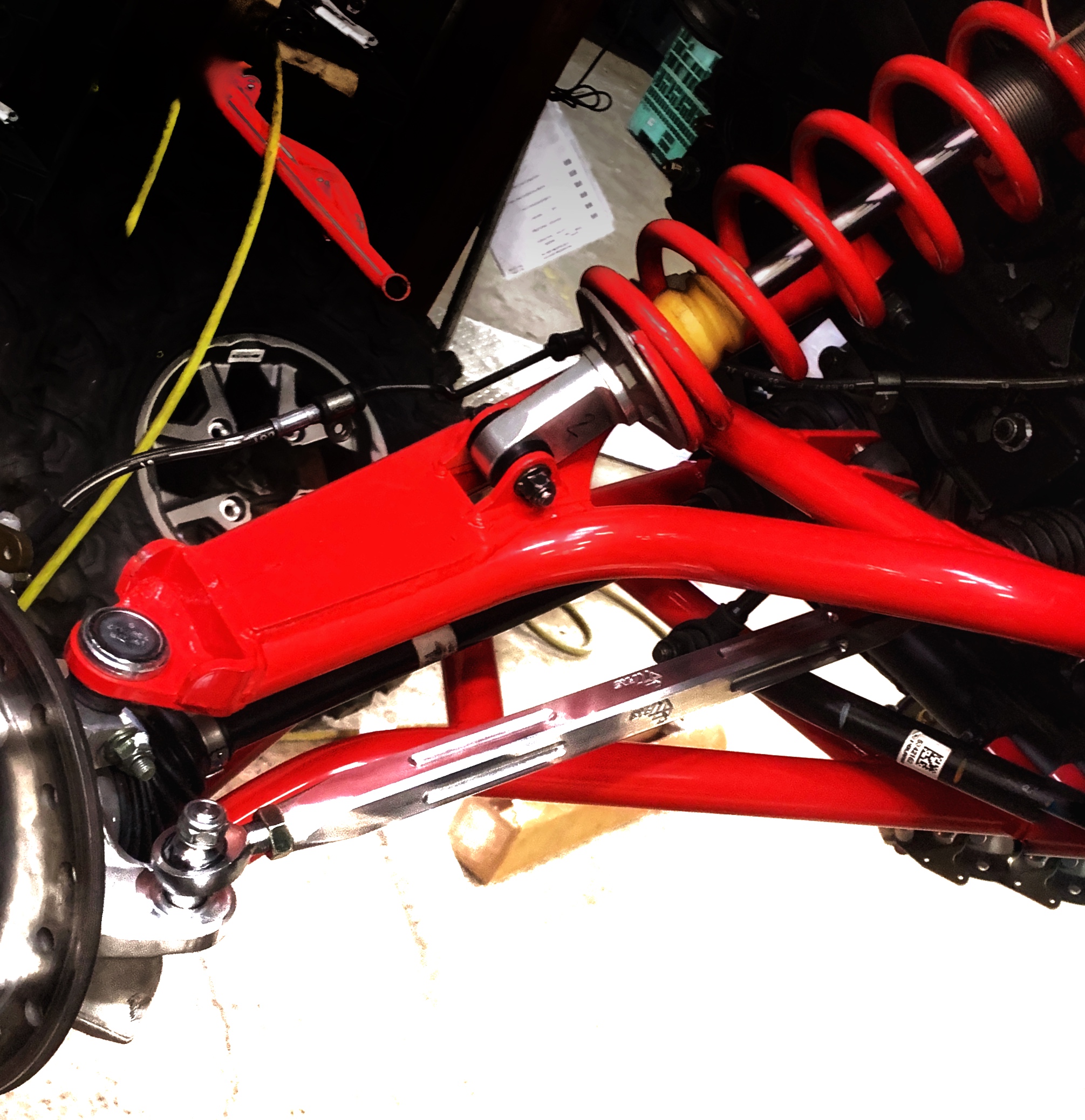michael.gonzalez
New member
- Jul 7, 2021
- 227
- 306
Well I hope it's machined from a properly selected material for the design.Did you read the article, that's not forged, thats BILLET! :makerain:
Last edited by a moderator:
Follow along with the video below to see how to install our site as a web app on your home screen.
Note: This feature may not be available in some browsers.
Well I hope it's machined from a properly selected material for the design.Did you read the article, that's not forged, thats BILLET! :makerain:
Bandaid? ALL engineering of mass-produced items is a bandaid. ALL suspension and chassis engineering, mass-produced or one-off, is a band-aid. You make compromises to meet your overall combination of capability, cost, packaging and service. There's no perfect solution. You pick your top priorities and make compromises somewhere else.I agree not insurmountable but it's still a bandaid for an issue which should have never existed from the beginning if they had mounted the shock to the lower and converted to front steer on their ground up end all be all UTV design.
You nor I will never know why it was done this way. It is what it is until the next iteration of the rzr.
Hate to start something and not finish... :biggrin:Agree to disagree I guess? :cheers:
ABC posted the pic.Easy big feller. Debates on the Internet are one thing, personal insults are another.
I’ll take this one as concession and chalk it up to one too many beers.
What's with all of the childish name calling?or you're just a prick?
Rockwood was a character in Roadhouse...?ABC posted the pic.
I just turned it into a nod to Roadhouse, if you didn't get it.

In addition to that, which brand of shock mfr uses a clevis as their standard mounting system?Regarding the clevis.
It is a chit design, no matter what Honda or Nissan it's been applied to.
Or a kibbetech or what not.
The proper design for 4wd offroad is either a single shock (or even co/bypass) with clearance or portal hubs.
Portals have been proven time and time again from the H1 to ultra4 cars and now 4wd TTs.
The clevis design is a bandaid to make things fit.
It is not progression and it has been shown to be hindrance in a high travel and aggressive application.
The Pro R design as I've stated before was a design from Polaris to either bypass the RG patents or simply to try a design which is not standard.
The latter really doesn't make sense since the Pro R was supposedly a ground up design/build and anybody with half a brain would mount the lower shock directly to the lower arm as it's been done for the last 30 years.
It's not rocket science.
It was done for a reason and it is not ideal. No matter which way you spin it.
ETA
I had a long edit here and it disappeared but basically stated, I belive in my uneducated opinion: the dual mounted system of a clevis fails in comparison to a single mounted shock system using a uniball/monorail. The single mounting point allows the little bit of give in the suspension deflection vs the dual mounted clevis.
I'm no engineer and I could be wrong.
I look at the top racecars in offroad and don't see any clevises front or rear. They were a flash in the pan.
It comes down to this, to any of the people here for or against, honest question here.
Based on you experience and opinion, if you had a choice, and money and design was no object would you rather your shock be mounted directly to the lower arm at a single point or would you favor having a clevis?
Disregard brand, make or model and be objective.
All of the major shock mfrs use the single point design, since it's the best.Portals have negative drive traits as they create a lever on the end of the suspension, add cost/complexity, reduce travel for a given track width, and add unsprung weight.
If I had the choice between a simple clevis and portals, I’m picking the clevis, especially considering the cost involved (which can’t be ignored).
Design wise, a clevis simply moves some load from the suspension arm to the shock end. As long as the system is designed properly, the marginal difference in weight and cost isn’t concerning.
Keep in mind that the force imparted by the shock isn’t going away because you used a heim. Rather than the clevis being beefy, you have to make the arm beefy since the heim will concentrate this load more. Since a heim can’t connect through the wheel centerline (axle in the way), you either have torsional loading on the arm (requiring moar beef) or you have to do something like portals as you mentioned to move the axle off of centerline, which (in addition to cost and complexity) would have a lot of really bad handling characteristics under power if it’s offset to the front or rear. I have a feeling we’d all miss “RZR bumps” if everything out there had portals to offset the axle centerline front:rear.
This is why a lot of OEMs with front wheel drive either use McStruts, crazy multilink designs (generally with the shock mounted to the upright), a simple clevis or a narrow shock extension below the body (to get the shock as close to the wheel centerline as possible) with conventional A arms.
Aww, come on. I'm talking facts, not belief. Why is this inferior? So far, to my knowledge, your arguments against were:Not at all, you wont change your position, and at this point neither will I.
I believe the clevis is an inferior design, it was unwarranted and unnecessary on a ground up design/build unless there were legal concerns involved. Hence why I called it a bandaid instead of creating a superior design. This is Polaris we are talking about. They have great engineers.
I will go further and state I believe their toe link design is inferior as well. I have hear real world feedback on that. Apparently with moderate to aggressive use, the rear needs to be realigned/checked constantly.
As I said, agree to disagree.
LOL. Here we go again...All of the major shock mfrs use the single point design, since it's the best.
A clevis is just a workaround for poor engineering. The bottom shock mount should be double sheer, which spreads the load far enough over the bottom a-arm to handle extreme loads of TTs doing 130+ mph through the desert.
That's pretty much tried and true in any rational mind.
It's all very simple. In any group of people, there are those who understand the forces involved and choose the best path to get the job done with the greatest strength reliability. Let's call them the majority of trophy designers and all of the shock mfrs. Then there are those constrained by patents or a lack of knowledge, or just a certain level of apathy and an overall "good enough for gov't work" attitude. Plus without built in weaknesses, they don't get to sell as many parts.
In conclusion, trophy truck designers and shock mfrs use the uniball design. It's sure odd how that works. Must be a huuuuge coincidence.

I personally very much dislike Polaris products, but I doubt the failure experienced in the race was any indication of an overall flawed design.
Oh, you mean the failure was a one-off? Why did they have to stop and change it out 3 times?
This type of shock mount, while not on fabricated one-off racecars, isn’t something new. More likely, they had a metallurgy issue and it failed. I’m fine with it, and if it has problems, it had more to do with execution than the concept. It’s not like they’ll have to completely redesign the front end…
I still don’t get why the material on a clevis needs to be over 42,000 psi.
For strength, obviously. Less than that and you end up stopping 3 times in a race to replace it. Just ask Polaris, they lived it.
Odd to specify material hardness for a shock mount without some other goal like dimensional or weight constraints.
That wasn't a unit of hardness. Rockwell is. PSI is used to measure strength.
Don't forget more testing prior to release to the public. They could have caught that problem in testing.Yep. And either they need a beefier clevis, or there was a metallurgical problem. Not insurmountable.
I legitimately believe legal issues are the sole if not the largest reason they went with the clevis. There is no other explanation.
It's not superior, it's not widely used in this industry and they had failures first race out.
Also I never said they should used portals, I'm on my phone and without going back I'm pretty sure I stated portals are the standard on the top tier racecars.
The other option was to simply package the front end properly in order to not use the clevis.
Correct me if I'm wrong.
That's odd.Aww, come on. I'm talking facts, not belief. Why is this inferior? So far, to my knowledge, your arguments against were:
They should've used portals. On a mass-produced item with an MSRP.
They broke when King used them on trailing arms. I believe we addressed this.
The clevis doesn't exceed 42,000psi. As an engineer, just giving material hardness for an item that doesn't directly come into contact with the fastener is like saying someone doesn't have enough cash because all they have are $20 bills. Material hardness is part of the equation, and you design the system around whatever it is you're using.
Trust me, I get what you're saying, but you're acting like this is chit design for the sole purpose of avoiding attorneys, but still discounting the biggest benefit of the clevis: it allows for the shock to be centered on the axle centerline without need for complex items that cause unwanted handling characteristics like portals. Mounting the shock this way reduces torsional loading on the control arm because when the shock mount isn't on the axle centerline, you create a lever between the tire and the shock. This causes problems since every time the vehicle hits a bump, the tire tries to twist the control arm as it transfers this energy to the damper. Add torque from the powertrain, and you have even more problems.

